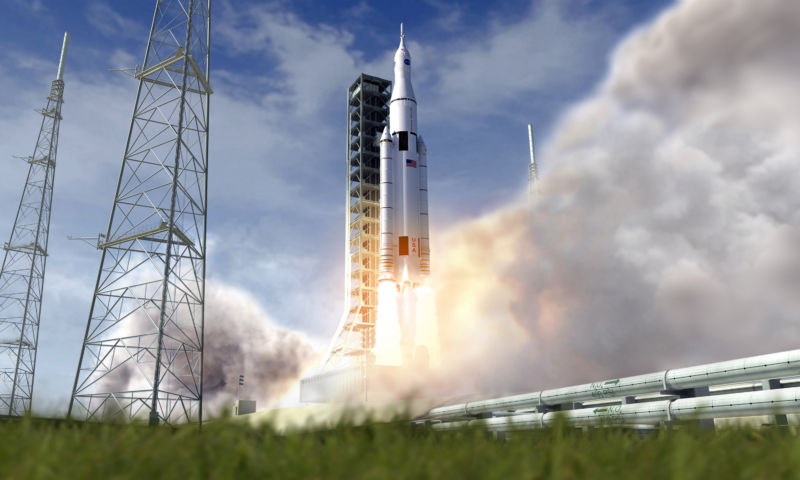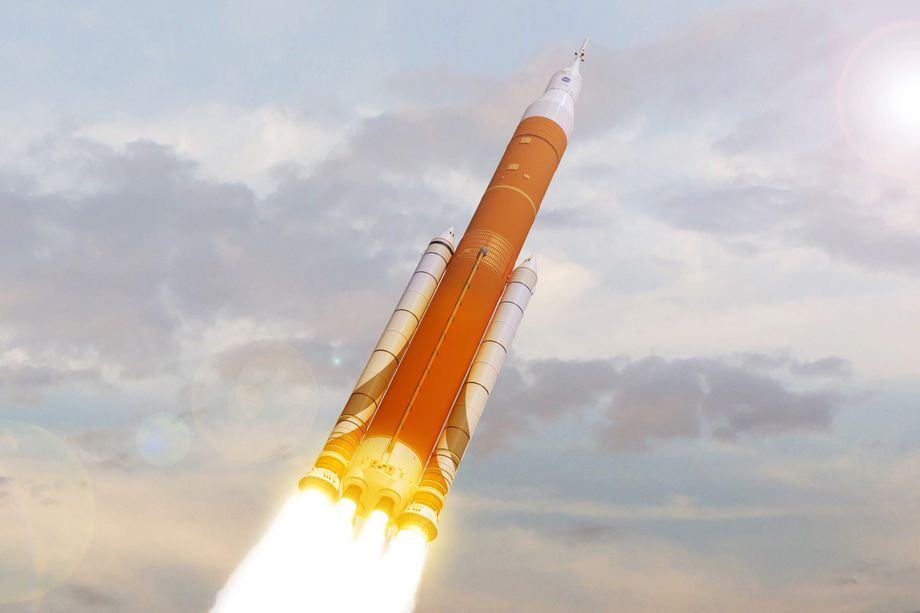NASA plans change: NASA’s heavy rocket launches are likely to take

Launching SLS through the eyes of an artist
Over the next few years, NASA plans to launch its own heavy rockets. This is a mission to deliver equipment and people to the moon. Initially, these launches were scheduled for 2018 and 2021, but, most likely, they will have to be postponed to a later date. SpaceX and Boeing are developing heavy and super heavy launch vehicles for NASA. As for the latter, its rocket is called the Space Launch System (SLS). According to the plan, the rocket should go on the flight next year.
According to the NASA plan, tests of the Boeing SLS launch vehicle and the SpaceX Orion capsule were to be carried out in the above timeframe. In November 2018, the Boeing heavy rocket should launch the Orion capsule into lunar orbit. The flight should be automatic, it will allow all systems to experience all systems without risk for people. And already in 2021 a second flight is scheduled, with a team of people. The flight duration is 8 days, the number of team members is 4.
Now the agency is working on the installation of ground structures on the launch pad. So the preparation of both missions is progressing. In particular, work is underway to create a mobile launch platform for SLS, and various structures of the launch pad at Cape Canaveral, at the Kennedy Space Center , are being upgraded to meet the needs of new missions.
')
Earlier it was reported that US President Donald Trump signed a document on the financing of all NASA programs, without particularly cutting back, except for refusing additional support for flights to Mars that Ilon Musk had lobbied for . But now at NASA they say that the level of funding for the program of flights to the moon is lower than recommended. In other words, the implementation of the program will be less fast than originally planned.
In addition, the program may be changes associated with all that was said above. For example, the first unmanned flight may be canceled, a capsule with people will fly to the Moon. Now NASA is exploring the possibility of manned flight to the moon, trying to anticipate all the troubles that may happen. But all this has not yet been confirmed, we are talking only about the alleged, and not approved actions. If it is decided to send people into space in the framework of the first mission, the agency will have to take on not only additional risks, but also additional expenses. "A preliminary assessment shows that this will require significant additional costs - money that is not so easy to get," - said earlier Bill Hill, a spokesman for NASA.
The presidential administration asked the leadership of NASA to conduct an assessment of the risks of changing plans. According to the agency’s management, if during the analysis it turns out that sending people into space as part of EM-1 is too dangerous, the previous plan will be upheld, and the first launch will be carried out automatically.
In the event of program changes, it will be necessary to refine the top stage of the rocket for a manned flight at a fast pace, to add a life support system for astronauts, to refine the Orion capsule. "We will have to disassemble what has already been done and modify the system to add the life support system that is needed for the flight," says Jason Crusan, the head of one of the NASA units.
All work on the flight to the moon is only preparation for a larger, that is, a manned expedition to Mars with the landing of people. In any case, as stated in NASA. Transfer of flights to the Moon, of course, affects the program of the flight to Mars, the dates are shifted to a later date. Part of this program is the creation of modules for Deep Space Gateway - a station located near the Moon, which will serve as an intermediate stage in the implementation of flights to the Moon and Mars.

There are now many gaps in this program. The exact timing of the implementation of a number of stages is unknown, the cost of creating the mentioned modules and other devices and structures is unknown. As a result, the US government strongly recommends that the agency quickly determine the plan, focusing on the implementation of its previously planned stages.
By the way, an important aspect of all this is money. Already, NASA has spent more than $ 15 billion on the Martian program. It is believed that by 2033 the amount of expenses will reach $ 210 billion. Therefore, now the government is asking the agency to think about where to save money. In addition, the administration of President Trump wants to show the tangible results of his work during the first presidential term of Donald Trump.
Source: https://habr.com/ru/post/403249/
All Articles